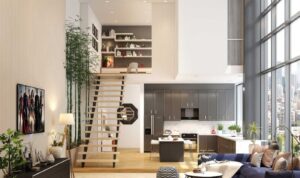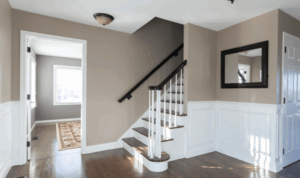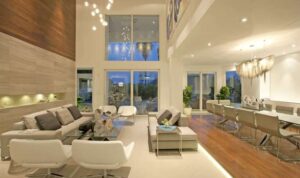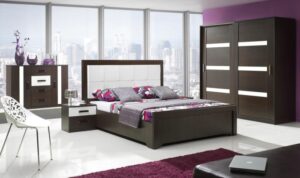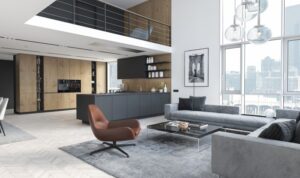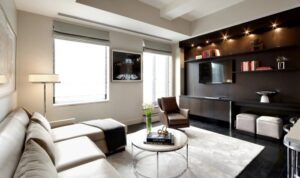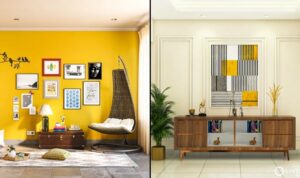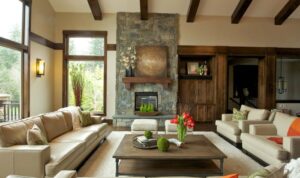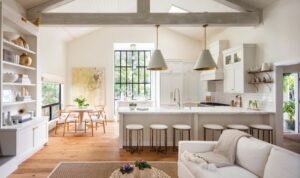Step into the realm of contemporary interior design, where innovation meets elegance. Discover the key elements, furniture styles, lighting techniques, and technology integration that define this modern aesthetic.
Definition of Contemporary Interior Design
Contemporary interior design refers to a style that is current and up-to-date, reflecting the design trends of the present time. It incorporates a mix of modern elements with a focus on clean lines, minimalism, and functionality.
Key Characteristics of Contemporary Interior Design
- Neutral color palette: Contemporary design typically uses neutral colors like white, beige, gray, or black as the base, with pops of bold colors for accents.
- Clean lines and smooth surfaces: Furniture and architectural elements in contemporary design are characterized by sleek and straight lines, creating a sense of simplicity and sophistication.
- Open and airy spaces: Contemporary interiors often feature open floor plans with plenty of natural light, creating a feeling of spaciousness and brightness.
- Mix of materials: Contemporary design incorporates a mix of materials like glass, metal, and wood to add texture and visual interest to the space.
Examples of How Contemporary Interior Design Differs from Other Styles
- Traditional design: Contemporary design differs from traditional styles by focusing on simplicity and minimalism, while traditional design tends to be more ornate and decorative.
- Modern design: While contemporary and modern design are often used interchangeably, modern design refers to a specific period in design history (late 19th to mid-20th century) and has a more defined aesthetic with a focus on function over form.
- Industrial design: Contemporary design differs from industrial style by incorporating softer elements and a more refined look, whereas industrial design features raw, unfinished materials and a rugged aesthetic.
Elements of Contemporary Interior Design
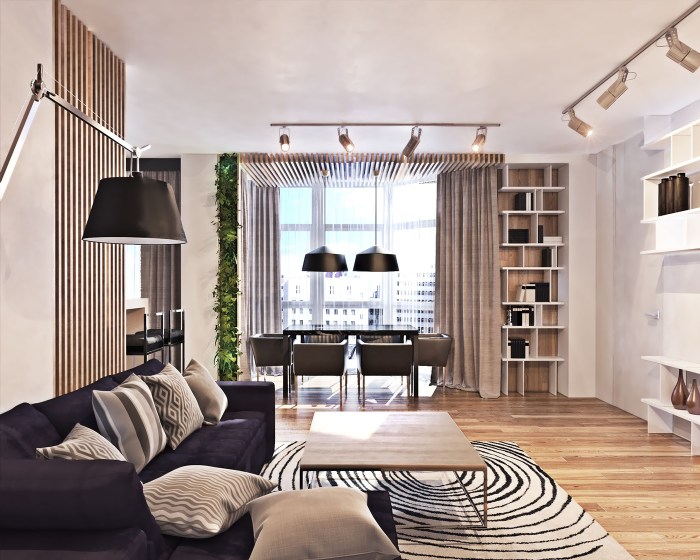
Contemporary interior design is characterized by clean lines, minimalism, and a focus on function. The elements that define contemporary interior design include:
Minimalism
- Minimalism plays a significant role in contemporary interior design by emphasizing simplicity and functionality.
- Spaces are decluttered and streamlined to create a sense of openness and tranquility.
- Minimalist furniture with sleek and simple designs are often used to complement the overall aesthetic.
Materials, Colors, and Textures
- Contemporary interior design makes use of a variety of materials such as glass, metal, and concrete to create a modern and industrial look.
- Neutral colors like white, black, and grey are commonly used as a base, with pops of bold colors added through accents like artwork or furniture.
- Textures such as smooth surfaces, natural fabrics, and rough finishes are incorporated to add depth and visual interest to the space.
Furniture and Layout in Contemporary Interior Design
In contemporary interior design, furniture plays a crucial role in setting the tone and style of a space. The choice of furniture and its layout can greatly impact the overall aesthetic and functionality of a contemporary design scheme.
Typical Furniture Styles in Contemporary Interior Design
- Minimalist: Clean lines, simple forms, and neutral colors are key features of minimalist furniture in contemporary design.
- Mid-Century Modern: Furniture pieces inspired by the mid-20th century design movement often feature organic shapes, sleek lines, and a mix of materials like wood and metal.
- Sleek and Streamlined: Furniture with smooth surfaces, glossy finishes, and geometric shapes are commonly used to create a sleek and contemporary look.
Furniture Layout in Contemporary Interior Design
The layout of furniture in a contemporary interior design scheme is essential for creating a sense of balance, flow, and functionality. Open floor plans, minimalistic arrangements, and strategic placement of furniture pieces can help to enhance the modern aesthetic of the space.
Importance of Functional and Stylish Furniture
- Functionality: In contemporary design, furniture not only needs to look stylish but also needs to serve a practical purpose. Multi-functional furniture pieces are often favored to maximize space efficiency.
- Style: Furniture serves as a focal point in contemporary interiors, adding personality and character to the space. Choosing furniture that complements the overall design theme is crucial for achieving a cohesive and visually appealing look.
Lighting and Accessories in Contemporary Interior Design
Lighting and accessories play a crucial role in enhancing the overall look and feel of contemporary interiors. They not only provide functionality but also add aesthetic value to the space.
Lighting Fixtures in Contemporary Interior Design
Contemporary interior design often incorporates sleek and minimalist lighting fixtures that blend seamlessly with the modern aesthetic. Some commonly used contemporary lighting fixtures include:
- Pendant Lights: These fixtures hang from the ceiling and come in various shapes and sizes, adding a stylish touch to the space.
- Track Lighting: Ideal for highlighting specific areas or objects in the room, track lighting offers versatility and a modern look.
- Recessed Lighting: Recessed lights are installed into the ceiling, providing a clean and unobtrusive lighting option for contemporary interiors.
Accessories in Contemporary Interior Design
Accessories in contemporary interior design are carefully selected to complement the overall aesthetic while adding personality and charm to the space. Some common accessories include:
- Abstract Artwork: Bold and abstract art pieces can add a pop of color and visual interest to a contemporary space.
- Minimalist Sculptures: Sculptures with clean lines and simple forms are popular choices for adding a modern touch to the decor.
- Textured Throw Pillows: Adding textured throw pillows in neutral tones can enhance the comfort and style of contemporary furniture pieces.
Technology Integration in Contemporary Interior Design
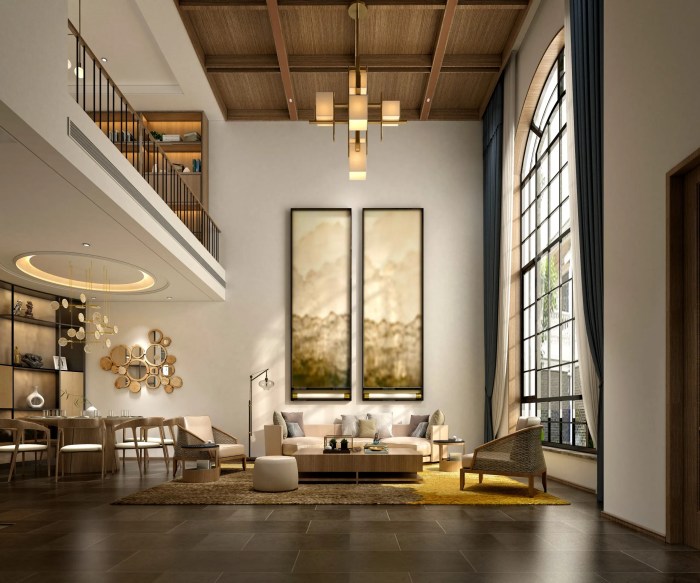
In contemporary interior design, technology plays a crucial role in enhancing both the functionality and aesthetics of spaces. By seamlessly integrating smart home features, designers can create modern and efficient living environments that align with the principles of contemporary design.
Smart Home Features in Contemporary Design
Smart home features such as automated lighting, temperature control, and security systems are commonly integrated into contemporary interiors. These technologies not only improve convenience and efficiency but also contribute to the overall sleek and modern look of the space.
Examples of Technology Enhancements
- Smart Lighting: LED lights with adjustable color temperatures and dimming options can be controlled via smartphone apps, allowing for customizable lighting schemes to suit different moods and activities.
- Voice-Activated Assistants: Devices like Amazon Echo or Google Home can be seamlessly incorporated into contemporary spaces, providing hands-free control over various functions like music, weather updates, and even home automation.
- Integrated Audio-Visual Systems: Hidden speakers, projectors, and screens can be discreetly installed to provide an immersive entertainment experience without compromising the clean and minimalist aesthetic of contemporary interiors.
End of Discussion
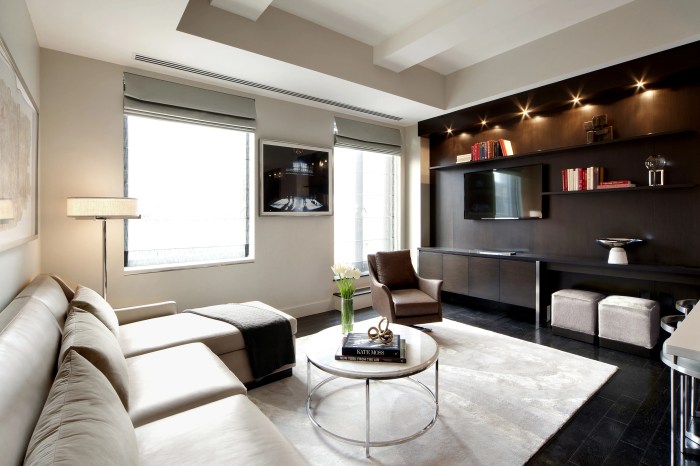
As we conclude our journey through contemporary interior design, it's evident that the marriage of functionality and style creates spaces that are both visually appealing and practical. Embrace the essence of contemporary design in your own living spaces and witness the transformation it brings.
Quick FAQs
What sets contemporary interior design apart from other styles?
Contemporary interior design focuses on clean lines, minimalism, and a blend of modern and traditional elements.
How does furniture layout contribute to the overall contemporary aesthetic?
Furniture layout in contemporary design emphasizes open spaces, functional pieces, and a sense of balance and harmony.
Why is lighting significant in enhancing contemporary interiors?
Lighting in contemporary design highlights architectural features, creates ambiance, and adds depth to the space.
How is technology integrated into contemporary interiors?
Technology in contemporary design includes smart home features, integrated sound systems, and automated lighting solutions.

